ENN523: Data Center Planning Report for GlobalNets - Proposal
VerifiedAdded on 2023/01/19
|15
|3207
|73
Report
AI Summary
This report provides a comprehensive data center planning proposal for GlobalNets, an IT firm seeking to expand its services. The report outlines key considerations such as specifications and standards including ANSI/TIA 942-A, Uptime Institute’s Tier Standard, and regulatory standards, crucial for designing and constructing the data center. It details the layered architecture approach, emphasizing the access, aggregation, and core layers to enhance resiliency and scalability. Furthermore, the report explores the benefits of virtualization, including server and Big Data virtualization, to optimize resource utilization and reduce costs. Finally, the report emphasizes the importance of security, recommending surveillance systems, security personnel, and access control mechanisms to protect the data center's integrity and data.

1
Data Centre Planning
Student Name
Institution
Date
Data Centre Planning
Student Name
Institution
Date
Paraphrase This Document
Need a fresh take? Get an instant paraphrase of this document with our AI Paraphraser
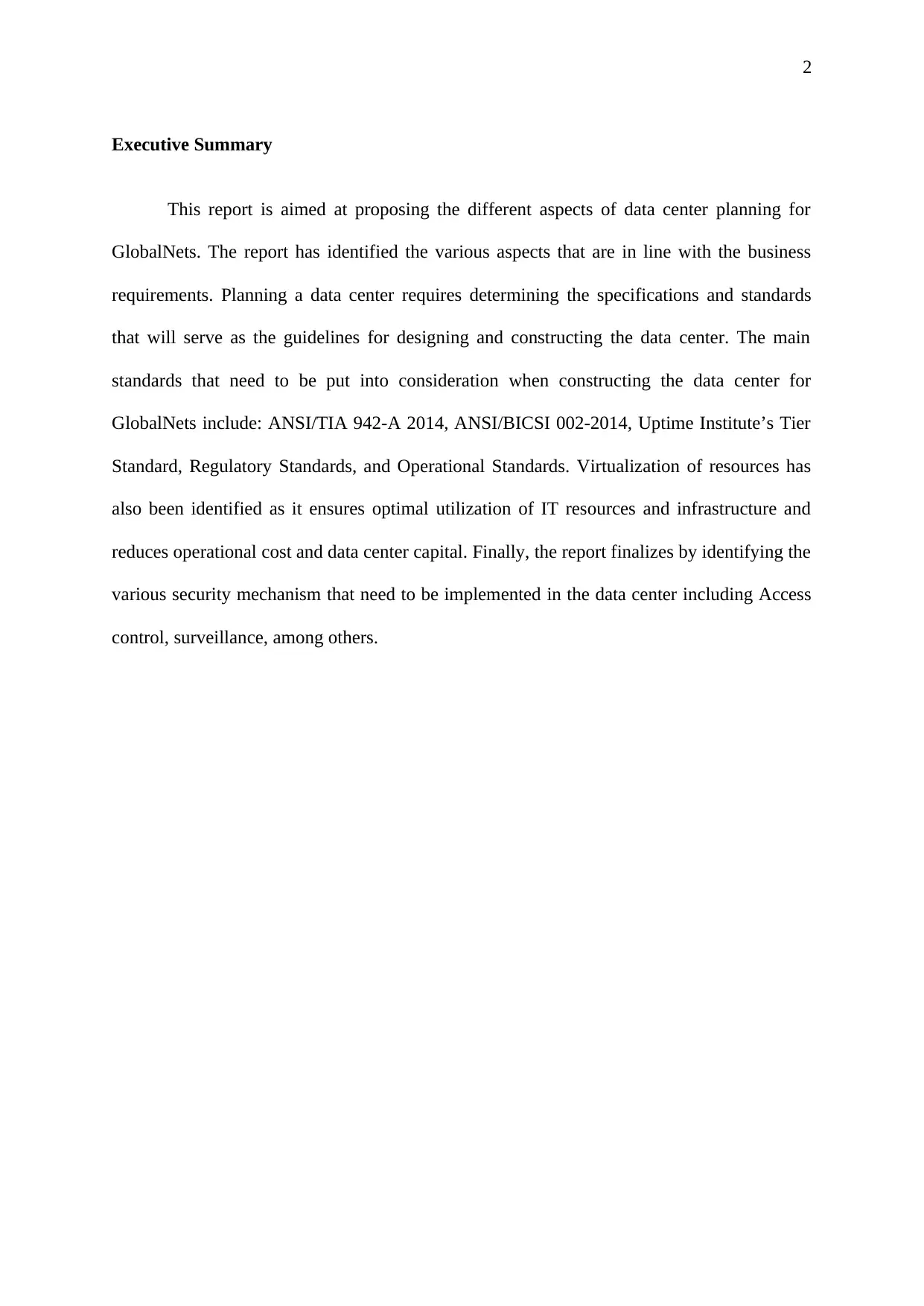
2
Executive Summary
This report is aimed at proposing the different aspects of data center planning for
GlobalNets. The report has identified the various aspects that are in line with the business
requirements. Planning a data center requires determining the specifications and standards
that will serve as the guidelines for designing and constructing the data center. The main
standards that need to be put into consideration when constructing the data center for
GlobalNets include: ANSI/TIA 942-A 2014, ANSI/BICSI 002-2014, Uptime Institute’s Tier
Standard, Regulatory Standards, and Operational Standards. Virtualization of resources has
also been identified as it ensures optimal utilization of IT resources and infrastructure and
reduces operational cost and data center capital. Finally, the report finalizes by identifying the
various security mechanism that need to be implemented in the data center including Access
control, surveillance, among others.
Executive Summary
This report is aimed at proposing the different aspects of data center planning for
GlobalNets. The report has identified the various aspects that are in line with the business
requirements. Planning a data center requires determining the specifications and standards
that will serve as the guidelines for designing and constructing the data center. The main
standards that need to be put into consideration when constructing the data center for
GlobalNets include: ANSI/TIA 942-A 2014, ANSI/BICSI 002-2014, Uptime Institute’s Tier
Standard, Regulatory Standards, and Operational Standards. Virtualization of resources has
also been identified as it ensures optimal utilization of IT resources and infrastructure and
reduces operational cost and data center capital. Finally, the report finalizes by identifying the
various security mechanism that need to be implemented in the data center including Access
control, surveillance, among others.
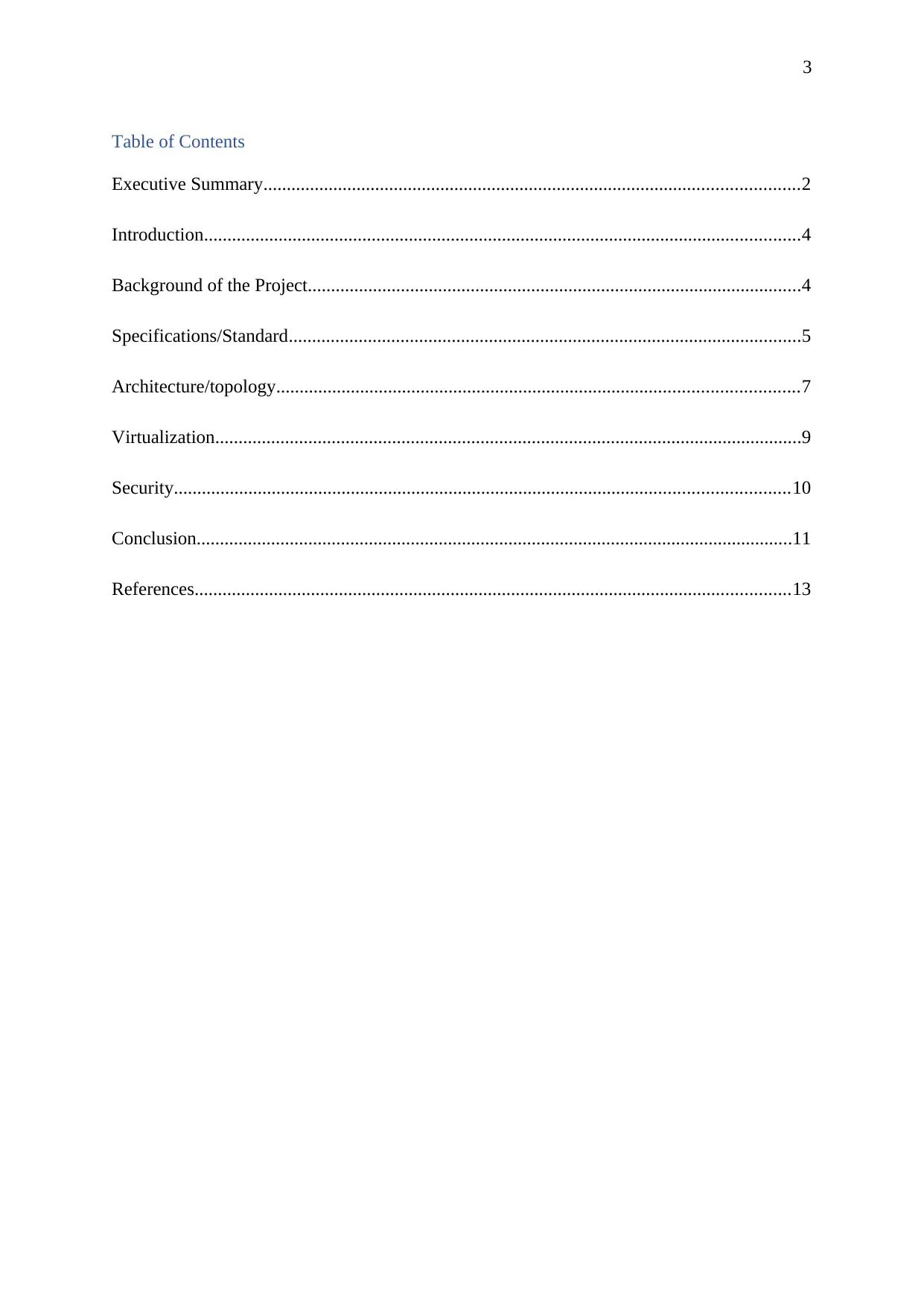
3
Table of Contents
Executive Summary...................................................................................................................2
Introduction................................................................................................................................4
Background of the Project..........................................................................................................4
Specifications/Standard..............................................................................................................5
Architecture/topology................................................................................................................7
Virtualization..............................................................................................................................9
Security....................................................................................................................................10
Conclusion................................................................................................................................11
References................................................................................................................................13
Table of Contents
Executive Summary...................................................................................................................2
Introduction................................................................................................................................4
Background of the Project..........................................................................................................4
Specifications/Standard..............................................................................................................5
Architecture/topology................................................................................................................7
Virtualization..............................................................................................................................9
Security....................................................................................................................................10
Conclusion................................................................................................................................11
References................................................................................................................................13
⊘ This is a preview!⊘
Do you want full access?
Subscribe today to unlock all pages.

Trusted by 1+ million students worldwide
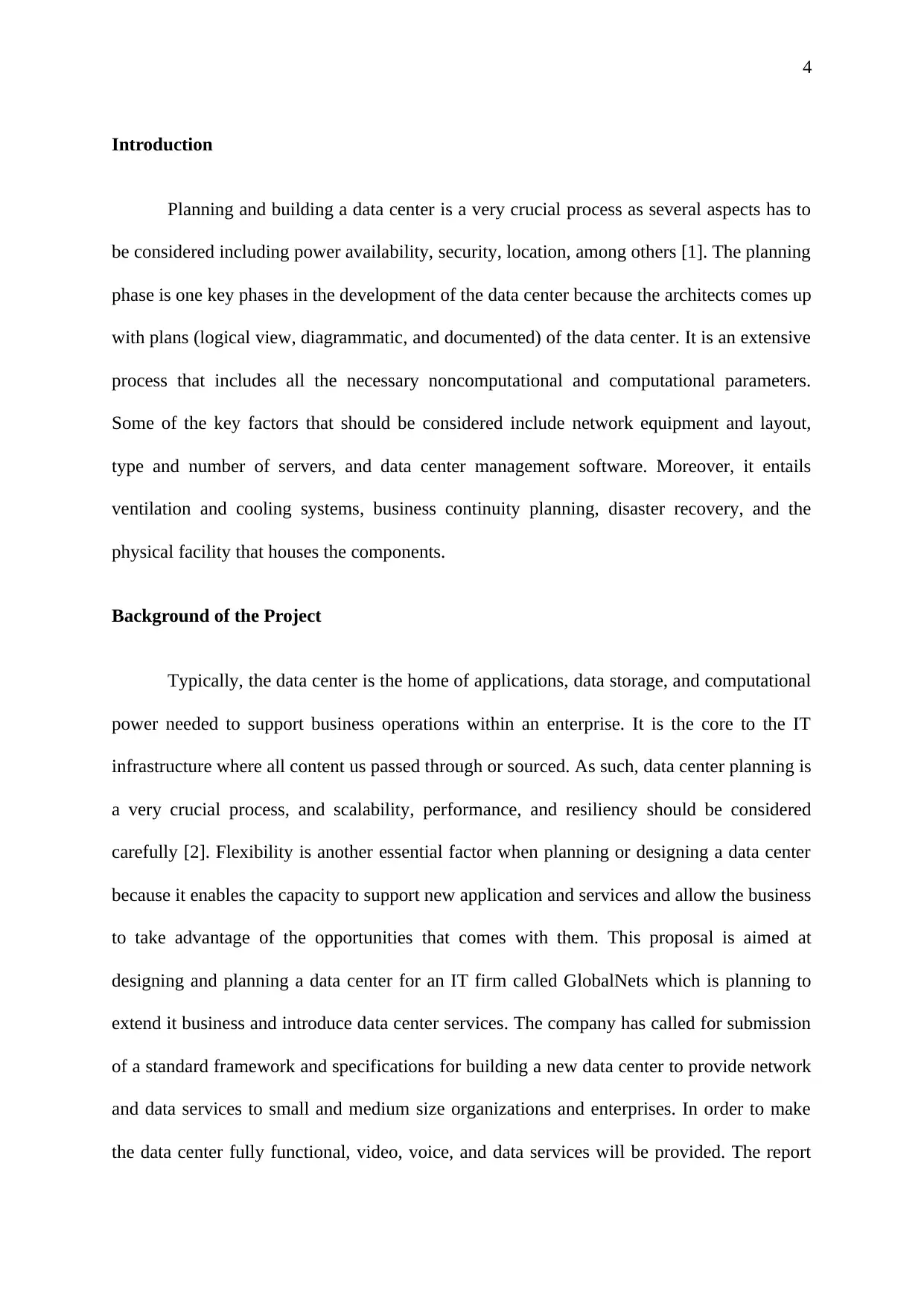
4
Introduction
Planning and building a data center is a very crucial process as several aspects has to
be considered including power availability, security, location, among others [1]. The planning
phase is one key phases in the development of the data center because the architects comes up
with plans (logical view, diagrammatic, and documented) of the data center. It is an extensive
process that includes all the necessary noncomputational and computational parameters.
Some of the key factors that should be considered include network equipment and layout,
type and number of servers, and data center management software. Moreover, it entails
ventilation and cooling systems, business continuity planning, disaster recovery, and the
physical facility that houses the components.
Background of the Project
Typically, the data center is the home of applications, data storage, and computational
power needed to support business operations within an enterprise. It is the core to the IT
infrastructure where all content us passed through or sourced. As such, data center planning is
a very crucial process, and scalability, performance, and resiliency should be considered
carefully [2]. Flexibility is another essential factor when planning or designing a data center
because it enables the capacity to support new application and services and allow the business
to take advantage of the opportunities that comes with them. This proposal is aimed at
designing and planning a data center for an IT firm called GlobalNets which is planning to
extend it business and introduce data center services. The company has called for submission
of a standard framework and specifications for building a new data center to provide network
and data services to small and medium size organizations and enterprises. In order to make
the data center fully functional, video, voice, and data services will be provided. The report
Introduction
Planning and building a data center is a very crucial process as several aspects has to
be considered including power availability, security, location, among others [1]. The planning
phase is one key phases in the development of the data center because the architects comes up
with plans (logical view, diagrammatic, and documented) of the data center. It is an extensive
process that includes all the necessary noncomputational and computational parameters.
Some of the key factors that should be considered include network equipment and layout,
type and number of servers, and data center management software. Moreover, it entails
ventilation and cooling systems, business continuity planning, disaster recovery, and the
physical facility that houses the components.
Background of the Project
Typically, the data center is the home of applications, data storage, and computational
power needed to support business operations within an enterprise. It is the core to the IT
infrastructure where all content us passed through or sourced. As such, data center planning is
a very crucial process, and scalability, performance, and resiliency should be considered
carefully [2]. Flexibility is another essential factor when planning or designing a data center
because it enables the capacity to support new application and services and allow the business
to take advantage of the opportunities that comes with them. This proposal is aimed at
designing and planning a data center for an IT firm called GlobalNets which is planning to
extend it business and introduce data center services. The company has called for submission
of a standard framework and specifications for building a new data center to provide network
and data services to small and medium size organizations and enterprises. In order to make
the data center fully functional, video, voice, and data services will be provided. The report
Paraphrase This Document
Need a fresh take? Get an instant paraphrase of this document with our AI Paraphraser
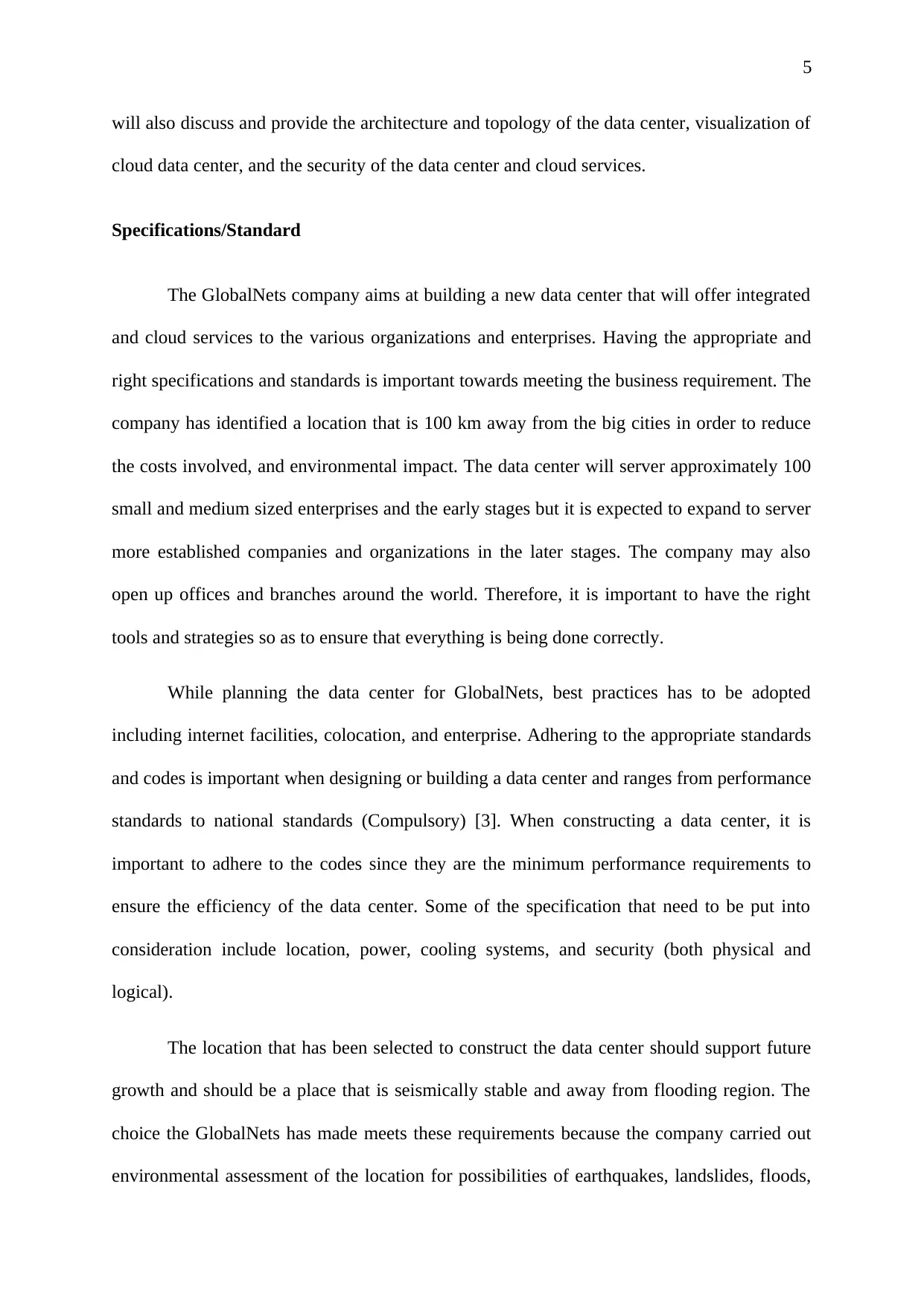
5
will also discuss and provide the architecture and topology of the data center, visualization of
cloud data center, and the security of the data center and cloud services.
Specifications/Standard
The GlobalNets company aims at building a new data center that will offer integrated
and cloud services to the various organizations and enterprises. Having the appropriate and
right specifications and standards is important towards meeting the business requirement. The
company has identified a location that is 100 km away from the big cities in order to reduce
the costs involved, and environmental impact. The data center will server approximately 100
small and medium sized enterprises and the early stages but it is expected to expand to server
more established companies and organizations in the later stages. The company may also
open up offices and branches around the world. Therefore, it is important to have the right
tools and strategies so as to ensure that everything is being done correctly.
While planning the data center for GlobalNets, best practices has to be adopted
including internet facilities, colocation, and enterprise. Adhering to the appropriate standards
and codes is important when designing or building a data center and ranges from performance
standards to national standards (Compulsory) [3]. When constructing a data center, it is
important to adhere to the codes since they are the minimum performance requirements to
ensure the efficiency of the data center. Some of the specification that need to be put into
consideration include location, power, cooling systems, and security (both physical and
logical).
The location that has been selected to construct the data center should support future
growth and should be a place that is seismically stable and away from flooding region. The
choice the GlobalNets has made meets these requirements because the company carried out
environmental assessment of the location for possibilities of earthquakes, landslides, floods,
will also discuss and provide the architecture and topology of the data center, visualization of
cloud data center, and the security of the data center and cloud services.
Specifications/Standard
The GlobalNets company aims at building a new data center that will offer integrated
and cloud services to the various organizations and enterprises. Having the appropriate and
right specifications and standards is important towards meeting the business requirement. The
company has identified a location that is 100 km away from the big cities in order to reduce
the costs involved, and environmental impact. The data center will server approximately 100
small and medium sized enterprises and the early stages but it is expected to expand to server
more established companies and organizations in the later stages. The company may also
open up offices and branches around the world. Therefore, it is important to have the right
tools and strategies so as to ensure that everything is being done correctly.
While planning the data center for GlobalNets, best practices has to be adopted
including internet facilities, colocation, and enterprise. Adhering to the appropriate standards
and codes is important when designing or building a data center and ranges from performance
standards to national standards (Compulsory) [3]. When constructing a data center, it is
important to adhere to the codes since they are the minimum performance requirements to
ensure the efficiency of the data center. Some of the specification that need to be put into
consideration include location, power, cooling systems, and security (both physical and
logical).
The location that has been selected to construct the data center should support future
growth and should be a place that is seismically stable and away from flooding region. The
choice the GlobalNets has made meets these requirements because the company carried out
environmental assessment of the location for possibilities of earthquakes, landslides, floods,
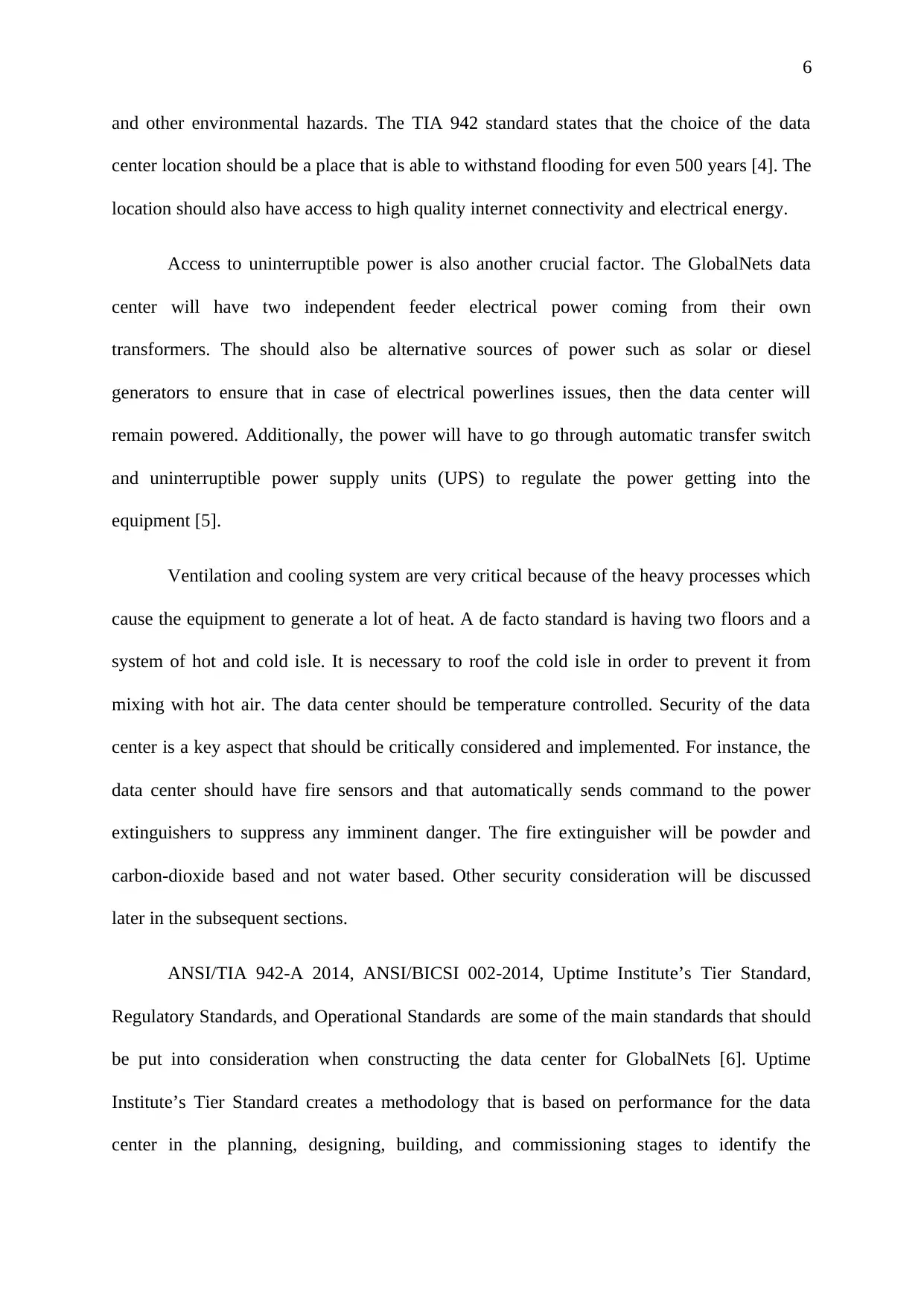
6
and other environmental hazards. The TIA 942 standard states that the choice of the data
center location should be a place that is able to withstand flooding for even 500 years [4]. The
location should also have access to high quality internet connectivity and electrical energy.
Access to uninterruptible power is also another crucial factor. The GlobalNets data
center will have two independent feeder electrical power coming from their own
transformers. The should also be alternative sources of power such as solar or diesel
generators to ensure that in case of electrical powerlines issues, then the data center will
remain powered. Additionally, the power will have to go through automatic transfer switch
and uninterruptible power supply units (UPS) to regulate the power getting into the
equipment [5].
Ventilation and cooling system are very critical because of the heavy processes which
cause the equipment to generate a lot of heat. A de facto standard is having two floors and a
system of hot and cold isle. It is necessary to roof the cold isle in order to prevent it from
mixing with hot air. The data center should be temperature controlled. Security of the data
center is a key aspect that should be critically considered and implemented. For instance, the
data center should have fire sensors and that automatically sends command to the power
extinguishers to suppress any imminent danger. The fire extinguisher will be powder and
carbon-dioxide based and not water based. Other security consideration will be discussed
later in the subsequent sections.
ANSI/TIA 942-A 2014, ANSI/BICSI 002-2014, Uptime Institute’s Tier Standard,
Regulatory Standards, and Operational Standards are some of the main standards that should
be put into consideration when constructing the data center for GlobalNets [6]. Uptime
Institute’s Tier Standard creates a methodology that is based on performance for the data
center in the planning, designing, building, and commissioning stages to identify the
and other environmental hazards. The TIA 942 standard states that the choice of the data
center location should be a place that is able to withstand flooding for even 500 years [4]. The
location should also have access to high quality internet connectivity and electrical energy.
Access to uninterruptible power is also another crucial factor. The GlobalNets data
center will have two independent feeder electrical power coming from their own
transformers. The should also be alternative sources of power such as solar or diesel
generators to ensure that in case of electrical powerlines issues, then the data center will
remain powered. Additionally, the power will have to go through automatic transfer switch
and uninterruptible power supply units (UPS) to regulate the power getting into the
equipment [5].
Ventilation and cooling system are very critical because of the heavy processes which
cause the equipment to generate a lot of heat. A de facto standard is having two floors and a
system of hot and cold isle. It is necessary to roof the cold isle in order to prevent it from
mixing with hot air. The data center should be temperature controlled. Security of the data
center is a key aspect that should be critically considered and implemented. For instance, the
data center should have fire sensors and that automatically sends command to the power
extinguishers to suppress any imminent danger. The fire extinguisher will be powder and
carbon-dioxide based and not water based. Other security consideration will be discussed
later in the subsequent sections.
ANSI/TIA 942-A 2014, ANSI/BICSI 002-2014, Uptime Institute’s Tier Standard,
Regulatory Standards, and Operational Standards are some of the main standards that should
be put into consideration when constructing the data center for GlobalNets [6]. Uptime
Institute’s Tier Standard creates a methodology that is based on performance for the data
center in the planning, designing, building, and commissioning stages to identify the
⊘ This is a preview!⊘
Do you want full access?
Subscribe today to unlock all pages.

Trusted by 1+ million students worldwide
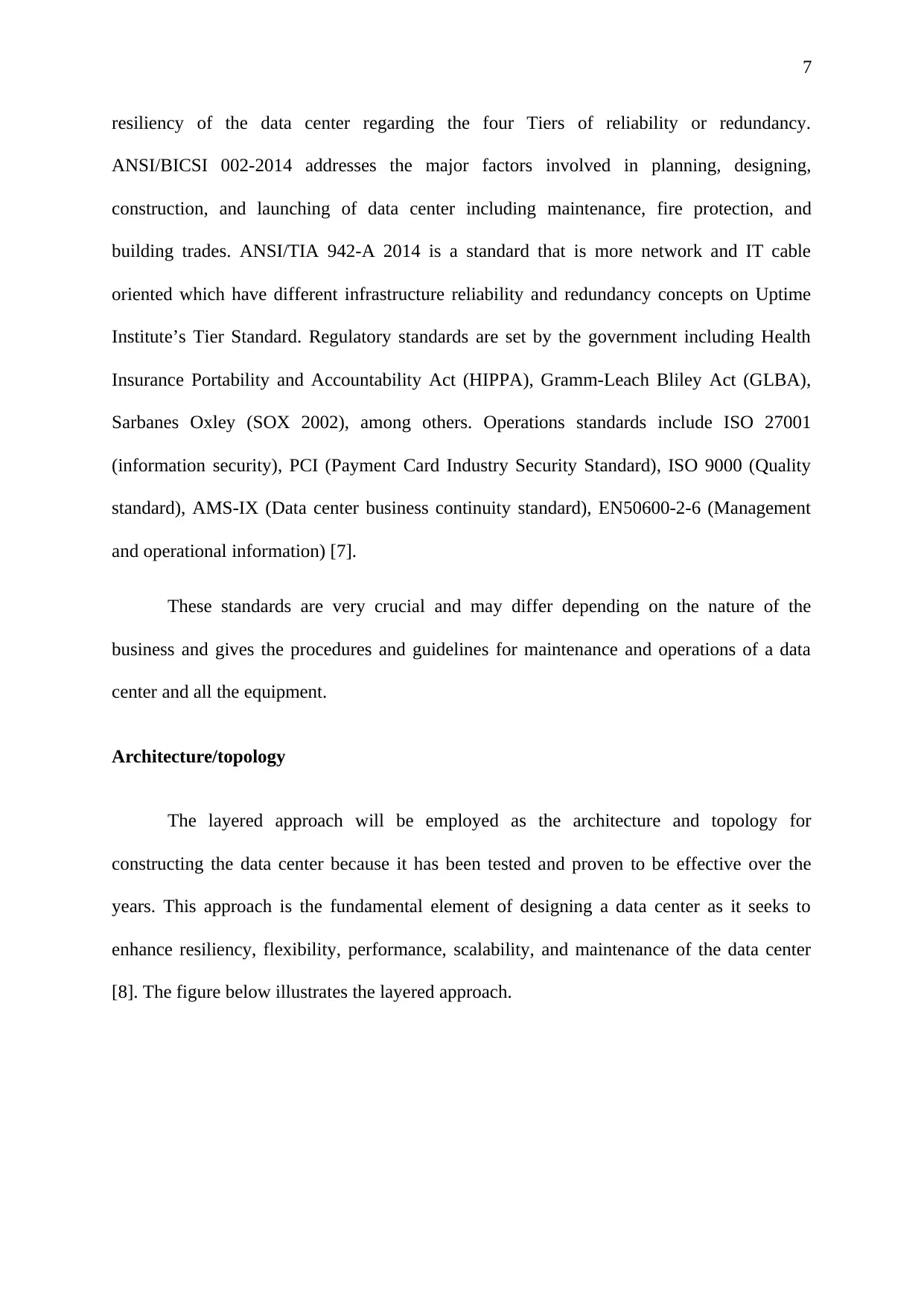
7
resiliency of the data center regarding the four Tiers of reliability or redundancy.
ANSI/BICSI 002-2014 addresses the major factors involved in planning, designing,
construction, and launching of data center including maintenance, fire protection, and
building trades. ANSI/TIA 942-A 2014 is a standard that is more network and IT cable
oriented which have different infrastructure reliability and redundancy concepts on Uptime
Institute’s Tier Standard. Regulatory standards are set by the government including Health
Insurance Portability and Accountability Act (HIPPA), Gramm-Leach Bliley Act (GLBA),
Sarbanes Oxley (SOX 2002), among others. Operations standards include ISO 27001
(information security), PCI (Payment Card Industry Security Standard), ISO 9000 (Quality
standard), AMS-IX (Data center business continuity standard), EN50600-2-6 (Management
and operational information) [7].
These standards are very crucial and may differ depending on the nature of the
business and gives the procedures and guidelines for maintenance and operations of a data
center and all the equipment.
Architecture/topology
The layered approach will be employed as the architecture and topology for
constructing the data center because it has been tested and proven to be effective over the
years. This approach is the fundamental element of designing a data center as it seeks to
enhance resiliency, flexibility, performance, scalability, and maintenance of the data center
[8]. The figure below illustrates the layered approach.
resiliency of the data center regarding the four Tiers of reliability or redundancy.
ANSI/BICSI 002-2014 addresses the major factors involved in planning, designing,
construction, and launching of data center including maintenance, fire protection, and
building trades. ANSI/TIA 942-A 2014 is a standard that is more network and IT cable
oriented which have different infrastructure reliability and redundancy concepts on Uptime
Institute’s Tier Standard. Regulatory standards are set by the government including Health
Insurance Portability and Accountability Act (HIPPA), Gramm-Leach Bliley Act (GLBA),
Sarbanes Oxley (SOX 2002), among others. Operations standards include ISO 27001
(information security), PCI (Payment Card Industry Security Standard), ISO 9000 (Quality
standard), AMS-IX (Data center business continuity standard), EN50600-2-6 (Management
and operational information) [7].
These standards are very crucial and may differ depending on the nature of the
business and gives the procedures and guidelines for maintenance and operations of a data
center and all the equipment.
Architecture/topology
The layered approach will be employed as the architecture and topology for
constructing the data center because it has been tested and proven to be effective over the
years. This approach is the fundamental element of designing a data center as it seeks to
enhance resiliency, flexibility, performance, scalability, and maintenance of the data center
[8]. The figure below illustrates the layered approach.
Paraphrase This Document
Need a fresh take? Get an instant paraphrase of this document with our AI Paraphraser
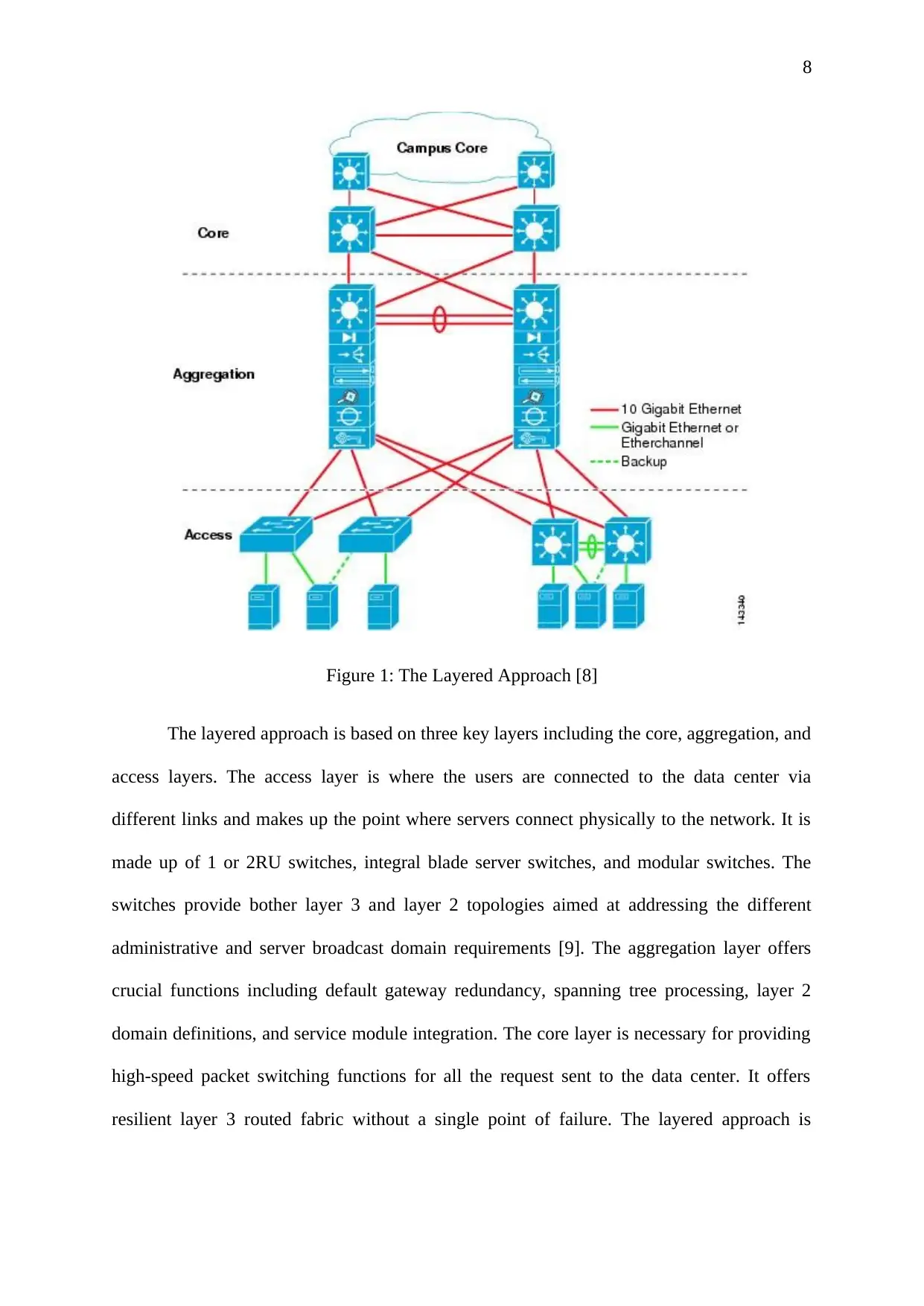
8
Figure 1: The Layered Approach [8]
The layered approach is based on three key layers including the core, aggregation, and
access layers. The access layer is where the users are connected to the data center via
different links and makes up the point where servers connect physically to the network. It is
made up of 1 or 2RU switches, integral blade server switches, and modular switches. The
switches provide bother layer 3 and layer 2 topologies aimed at addressing the different
administrative and server broadcast domain requirements [9]. The aggregation layer offers
crucial functions including default gateway redundancy, spanning tree processing, layer 2
domain definitions, and service module integration. The core layer is necessary for providing
high-speed packet switching functions for all the request sent to the data center. It offers
resilient layer 3 routed fabric without a single point of failure. The layered approach is
Figure 1: The Layered Approach [8]
The layered approach is based on three key layers including the core, aggregation, and
access layers. The access layer is where the users are connected to the data center via
different links and makes up the point where servers connect physically to the network. It is
made up of 1 or 2RU switches, integral blade server switches, and modular switches. The
switches provide bother layer 3 and layer 2 topologies aimed at addressing the different
administrative and server broadcast domain requirements [9]. The aggregation layer offers
crucial functions including default gateway redundancy, spanning tree processing, layer 2
domain definitions, and service module integration. The core layer is necessary for providing
high-speed packet switching functions for all the request sent to the data center. It offers
resilient layer 3 routed fabric without a single point of failure. The layered approach is
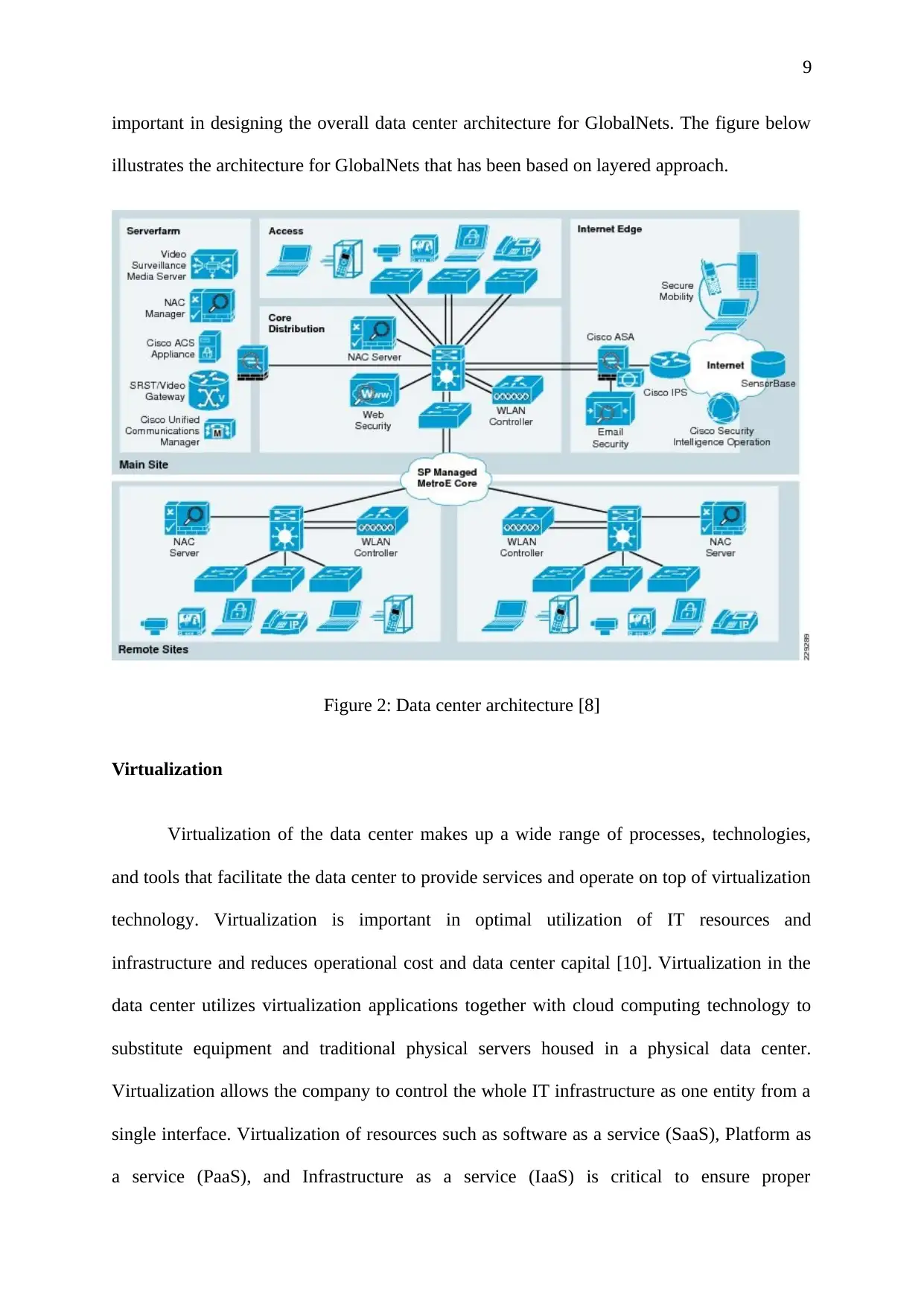
9
important in designing the overall data center architecture for GlobalNets. The figure below
illustrates the architecture for GlobalNets that has been based on layered approach.
Figure 2: Data center architecture [8]
Virtualization
Virtualization of the data center makes up a wide range of processes, technologies,
and tools that facilitate the data center to provide services and operate on top of virtualization
technology. Virtualization is important in optimal utilization of IT resources and
infrastructure and reduces operational cost and data center capital [10]. Virtualization in the
data center utilizes virtualization applications together with cloud computing technology to
substitute equipment and traditional physical servers housed in a physical data center.
Virtualization allows the company to control the whole IT infrastructure as one entity from a
single interface. Virtualization of resources such as software as a service (SaaS), Platform as
a service (PaaS), and Infrastructure as a service (IaaS) is critical to ensure proper
important in designing the overall data center architecture for GlobalNets. The figure below
illustrates the architecture for GlobalNets that has been based on layered approach.
Figure 2: Data center architecture [8]
Virtualization
Virtualization of the data center makes up a wide range of processes, technologies,
and tools that facilitate the data center to provide services and operate on top of virtualization
technology. Virtualization is important in optimal utilization of IT resources and
infrastructure and reduces operational cost and data center capital [10]. Virtualization in the
data center utilizes virtualization applications together with cloud computing technology to
substitute equipment and traditional physical servers housed in a physical data center.
Virtualization allows the company to control the whole IT infrastructure as one entity from a
single interface. Virtualization of resources such as software as a service (SaaS), Platform as
a service (PaaS), and Infrastructure as a service (IaaS) is critical to ensure proper
⊘ This is a preview!⊘
Do you want full access?
Subscribe today to unlock all pages.

Trusted by 1+ million students worldwide
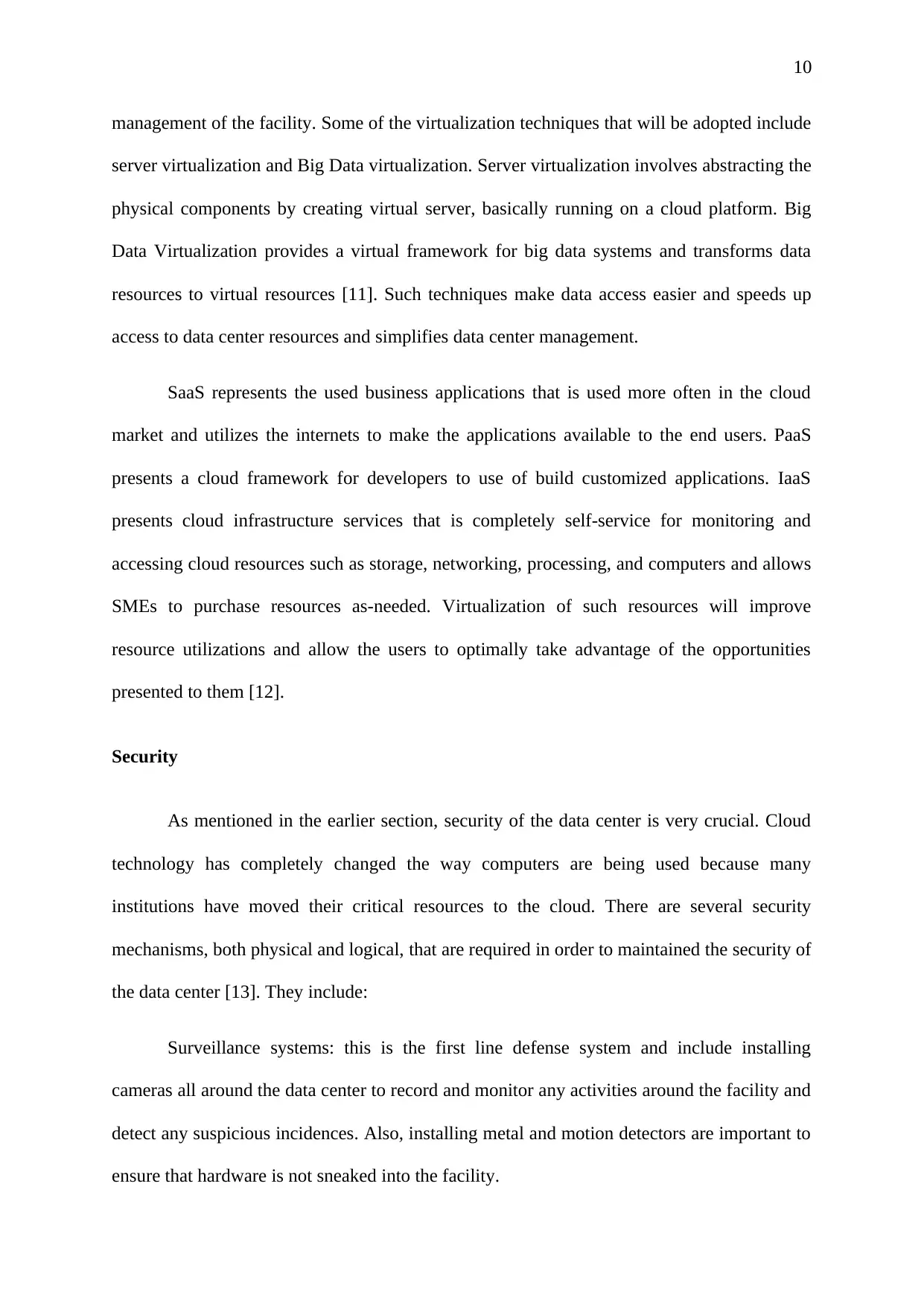
10
management of the facility. Some of the virtualization techniques that will be adopted include
server virtualization and Big Data virtualization. Server virtualization involves abstracting the
physical components by creating virtual server, basically running on a cloud platform. Big
Data Virtualization provides a virtual framework for big data systems and transforms data
resources to virtual resources [11]. Such techniques make data access easier and speeds up
access to data center resources and simplifies data center management.
SaaS represents the used business applications that is used more often in the cloud
market and utilizes the internets to make the applications available to the end users. PaaS
presents a cloud framework for developers to use of build customized applications. IaaS
presents cloud infrastructure services that is completely self-service for monitoring and
accessing cloud resources such as storage, networking, processing, and computers and allows
SMEs to purchase resources as-needed. Virtualization of such resources will improve
resource utilizations and allow the users to optimally take advantage of the opportunities
presented to them [12].
Security
As mentioned in the earlier section, security of the data center is very crucial. Cloud
technology has completely changed the way computers are being used because many
institutions have moved their critical resources to the cloud. There are several security
mechanisms, both physical and logical, that are required in order to maintained the security of
the data center [13]. They include:
Surveillance systems: this is the first line defense system and include installing
cameras all around the data center to record and monitor any activities around the facility and
detect any suspicious incidences. Also, installing metal and motion detectors are important to
ensure that hardware is not sneaked into the facility.
management of the facility. Some of the virtualization techniques that will be adopted include
server virtualization and Big Data virtualization. Server virtualization involves abstracting the
physical components by creating virtual server, basically running on a cloud platform. Big
Data Virtualization provides a virtual framework for big data systems and transforms data
resources to virtual resources [11]. Such techniques make data access easier and speeds up
access to data center resources and simplifies data center management.
SaaS represents the used business applications that is used more often in the cloud
market and utilizes the internets to make the applications available to the end users. PaaS
presents a cloud framework for developers to use of build customized applications. IaaS
presents cloud infrastructure services that is completely self-service for monitoring and
accessing cloud resources such as storage, networking, processing, and computers and allows
SMEs to purchase resources as-needed. Virtualization of such resources will improve
resource utilizations and allow the users to optimally take advantage of the opportunities
presented to them [12].
Security
As mentioned in the earlier section, security of the data center is very crucial. Cloud
technology has completely changed the way computers are being used because many
institutions have moved their critical resources to the cloud. There are several security
mechanisms, both physical and logical, that are required in order to maintained the security of
the data center [13]. They include:
Surveillance systems: this is the first line defense system and include installing
cameras all around the data center to record and monitor any activities around the facility and
detect any suspicious incidences. Also, installing metal and motion detectors are important to
ensure that hardware is not sneaked into the facility.
Paraphrase This Document
Need a fresh take? Get an instant paraphrase of this document with our AI Paraphraser
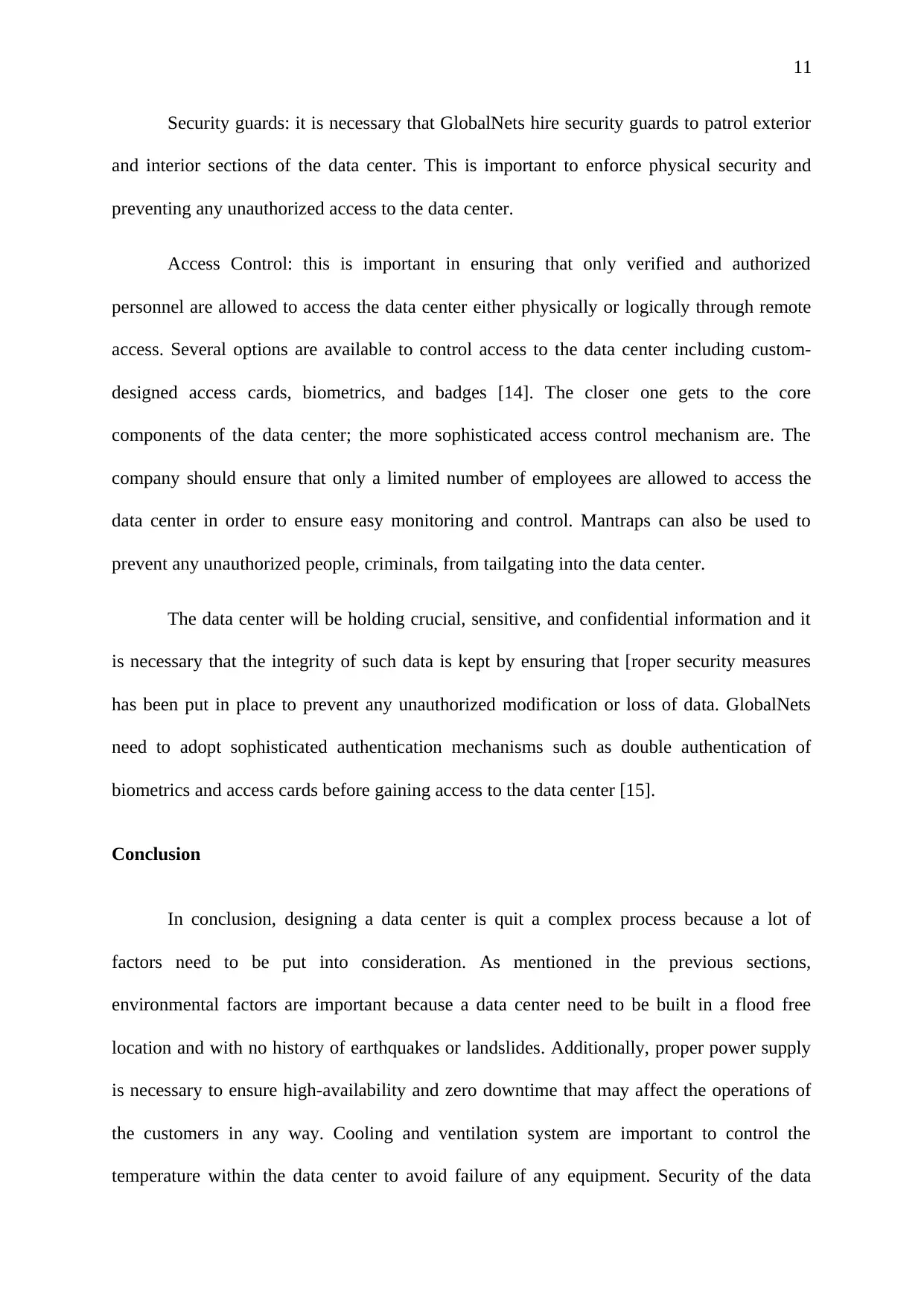
11
Security guards: it is necessary that GlobalNets hire security guards to patrol exterior
and interior sections of the data center. This is important to enforce physical security and
preventing any unauthorized access to the data center.
Access Control: this is important in ensuring that only verified and authorized
personnel are allowed to access the data center either physically or logically through remote
access. Several options are available to control access to the data center including custom-
designed access cards, biometrics, and badges [14]. The closer one gets to the core
components of the data center; the more sophisticated access control mechanism are. The
company should ensure that only a limited number of employees are allowed to access the
data center in order to ensure easy monitoring and control. Mantraps can also be used to
prevent any unauthorized people, criminals, from tailgating into the data center.
The data center will be holding crucial, sensitive, and confidential information and it
is necessary that the integrity of such data is kept by ensuring that [roper security measures
has been put in place to prevent any unauthorized modification or loss of data. GlobalNets
need to adopt sophisticated authentication mechanisms such as double authentication of
biometrics and access cards before gaining access to the data center [15].
Conclusion
In conclusion, designing a data center is quit a complex process because a lot of
factors need to be put into consideration. As mentioned in the previous sections,
environmental factors are important because a data center need to be built in a flood free
location and with no history of earthquakes or landslides. Additionally, proper power supply
is necessary to ensure high-availability and zero downtime that may affect the operations of
the customers in any way. Cooling and ventilation system are important to control the
temperature within the data center to avoid failure of any equipment. Security of the data
Security guards: it is necessary that GlobalNets hire security guards to patrol exterior
and interior sections of the data center. This is important to enforce physical security and
preventing any unauthorized access to the data center.
Access Control: this is important in ensuring that only verified and authorized
personnel are allowed to access the data center either physically or logically through remote
access. Several options are available to control access to the data center including custom-
designed access cards, biometrics, and badges [14]. The closer one gets to the core
components of the data center; the more sophisticated access control mechanism are. The
company should ensure that only a limited number of employees are allowed to access the
data center in order to ensure easy monitoring and control. Mantraps can also be used to
prevent any unauthorized people, criminals, from tailgating into the data center.
The data center will be holding crucial, sensitive, and confidential information and it
is necessary that the integrity of such data is kept by ensuring that [roper security measures
has been put in place to prevent any unauthorized modification or loss of data. GlobalNets
need to adopt sophisticated authentication mechanisms such as double authentication of
biometrics and access cards before gaining access to the data center [15].
Conclusion
In conclusion, designing a data center is quit a complex process because a lot of
factors need to be put into consideration. As mentioned in the previous sections,
environmental factors are important because a data center need to be built in a flood free
location and with no history of earthquakes or landslides. Additionally, proper power supply
is necessary to ensure high-availability and zero downtime that may affect the operations of
the customers in any way. Cooling and ventilation system are important to control the
temperature within the data center to avoid failure of any equipment. Security of the data

12
center is fundamental. The data center should be secured and protected from any
unauthorized access and this can be achieved through implementation of sophisticated access
control mechanisms, surveillance systems, security guards among other measures. This will
ensure that clients data remains secure and protected from any modification or access by
criminals. This proposal has presented several aspects that are important in planning and
designing a data center.
center is fundamental. The data center should be secured and protected from any
unauthorized access and this can be achieved through implementation of sophisticated access
control mechanisms, surveillance systems, security guards among other measures. This will
ensure that clients data remains secure and protected from any modification or access by
criminals. This proposal has presented several aspects that are important in planning and
designing a data center.
⊘ This is a preview!⊘
Do you want full access?
Subscribe today to unlock all pages.

Trusted by 1+ million students worldwide
1 out of 15
Related Documents
Your All-in-One AI-Powered Toolkit for Academic Success.
+13062052269
info@desklib.com
Available 24*7 on WhatsApp / Email
![[object Object]](/_next/static/media/star-bottom.7253800d.svg)
Unlock your academic potential
Copyright © 2020–2025 A2Z Services. All Rights Reserved. Developed and managed by ZUCOL.



